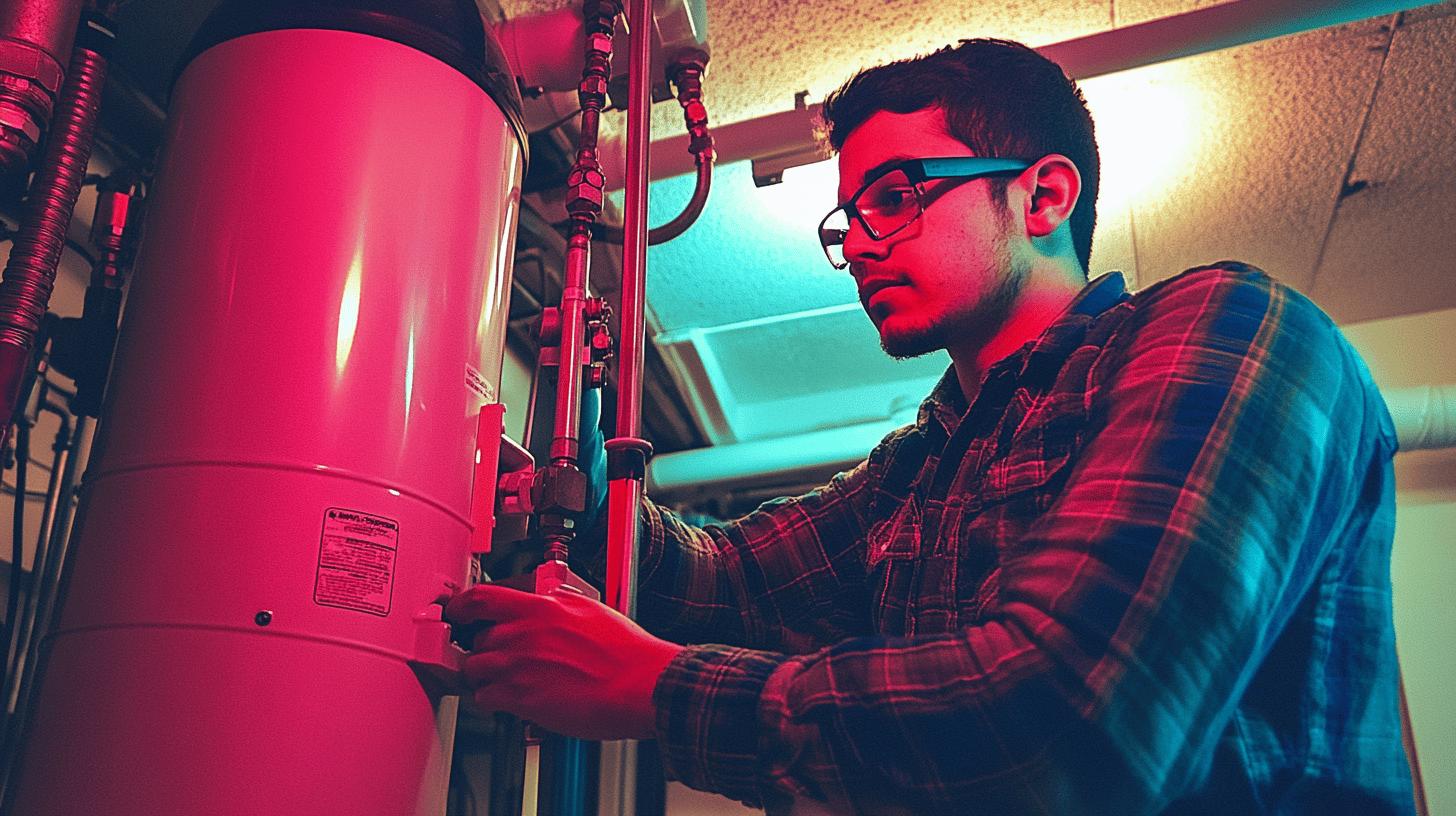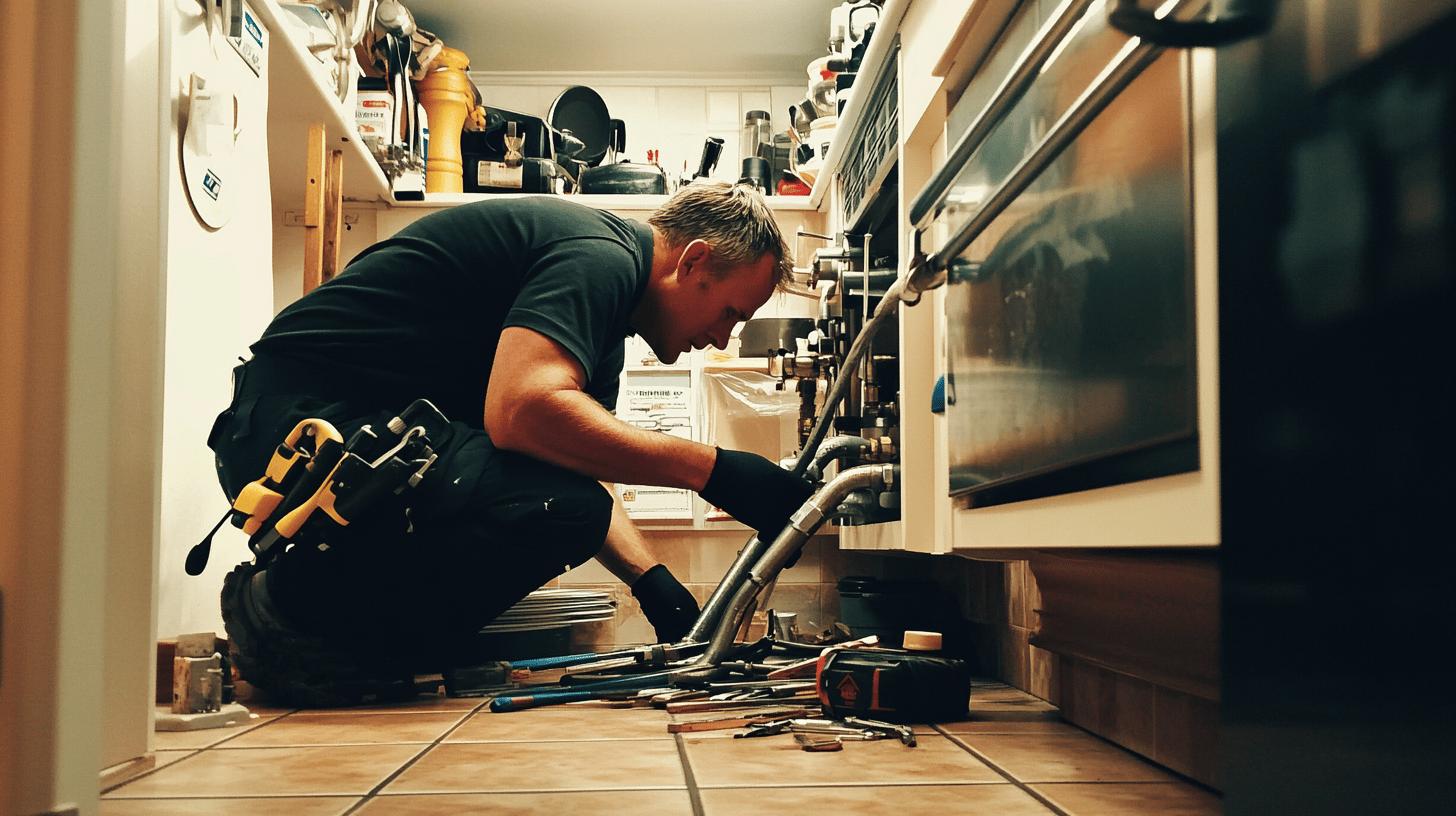TL;DR:
- Structured commercial plumbing maintenance is crucial for efficiency and longevity.
- Essential tasks include:
- Routine inspections
- Leak checks
- Backflow device tests
- Sump pump assessments
- Hydro jetting
- Valve tests
- Water heater checks
- Pipe corrosion evaluations
- Safety protocol reviews
- Emergency preparedness
- Suggested inspection frequency:
- Daily: Leak checks
- Weekly: Water pressure tests
- Monthly: Pipe corrosion checks
- Quarterly: Sump pump checks
- Semi-Annually: Backflow testing
- Annually: Comprehensive inspections
- Compliance with plumbing standards ensures safety and legal adherence.
Is your commercial building’s plumbing ready for surprises? Keeping your plumbing running smoothly is super important because any downtime can really mess things up. A solid plumbing maintenance checklist can help you avoid expensive repairs and keep everything on track. In this article, we’ll go over a detailed checklist of key maintenance tasks, from fixing faucets to hydro jetting for clogs. Get your facility management team the info they need to boost plumbing efficiency and meet regulations. Let’s dive in and make sure your systems last longer!
Comprehensive Commercial Plumbing Maintenance Checklist
Having a structured commercial plumbing checklist is crucial. It helps keep plumbing systems in commercial buildings running smoothly and lasting longer. Why does this matter? Good maintenance cuts down on the chances of expensive emergency repairs and extends the life of your plumbing fixtures. Regularly scheduled checks let facility managers tackle small problems before they turn into big headaches. This proactive approach not only improves system efficiency but also makes sure you’re following industry standards.
Here’s a list of essential tasks for your commercial plumbing maintenance checklist:
- Routine inspections of plumbing fixtures
- Checking for leaks and water damage
- Testing backflow prevention devices
- Sump pump functionality assessments
- Hydro jetting for drain cleaning
- Valve function tests
- Water heater inspections
- Pipe corrosion checks
- Safety protocol reviews
- Emergency preparedness planning
Professional plumbers play a key role in keeping plumbing systems efficient and up to code. How do they do this? Their expertise and access to the latest technology help them diagnose and fix problems effectively. They handle tasks like hydro jetting and backflow testing with precision. By trusting professionals, businesses can make sure their plumbing systems meet regulations and run smoothly.
Preventative Maintenance Strategies for Commercial Plumbing

Why is preventive maintenance important in commercial plumbing? It’s a smart way to save money by avoiding the high costs of emergency repairs. By catching problems early, you can lower repair costs and prevent water damage. Regular inspections of key parts like water heaters, sump pumps, and backflow preventers keep the system reliable and efficient. Having a structured maintenance plan ensures everything works well, leading to cost savings and better long-term performance.
| Maintenance Task | Frequency |
|---|---|
| Inspect water heaters | Quarterly |
| Check sump pump functionality | Monthly |
| Test backflow prevention devices | Semi-Annually |
| Conduct pipe corrosion checks | Annually |
| Review safety protocols | Annually |
How do professionals improve preventive maintenance? Their expertise guarantees that maintenance tasks are done accurately and thoroughly. They have the specialized knowledge and tools needed to carry out inspections and repairs correctly, which reduces future risks. Professionals also ensure compliance with industry standards, making preventive strategies more effective. This gives you peace of mind, knowing your plumbing systems are well-maintained and will last longer.
Regular Plumbing Inspection and Maintenance Schedule
A solid maintenance schedule is essential for keeping plumbing running smoothly in commercial buildings. Regular inspections help catch small problems before they turn into costly repairs and downtime. So, how often should these checks happen? Daily inspections can spot leaks and unusual noises that might signal bigger issues. Monthly checks focus on pipe integrity, looking for corrosion and leaks. Then, annual comprehensive inspections give an overall view of the system to catch any potential problems. Sticking to this schedule helps businesses maintain plumbing efficiency and avoid unexpected breakdowns.
- Daily: Leak checks, unusual noises
- Weekly: Water pressure and temperature tests
- Monthly: Pipe corrosion inspection
- Annually: Comprehensive system inspection
- Quarterly: Sump pump functionality checks
- Semi-Annually: Backflow prevention testing
Facility managers play a key role in making sure plumbing maintenance gets done consistently and effectively. Why is their job so important? They oversee maintenance tasks, which helps keep plumbing systems running efficiently and extend their lifespan. Managers work closely with plumbers to ensure tasks are done correctly, using the right tools and expertise. This teamwork leads to thorough inspections, compliance with regulations, and quick repairs when needed. Their efforts help ensure that plumbing operations in buildings run smoothly.
Key Components and Tools for Effective Plumbing Maintenance

Why are the right tools important for plumbing maintenance? They make inspections and repairs easier and more efficient. With the right tools, facility managers and their teams can perform tasks accurately, cutting down on mistakes and saving time. This helps them quickly identify and solve problems before they become bigger issues that could disrupt operations.
So, what tools are essential for plumbing maintenance? Pressure gauges, drain snakes, and valve testers are must-haves. Pressure gauges help maintain the right water pressure to prevent pipe damage. Drain snakes clear out blockages to keep water flowing smoothly. Valve testers check if valves are working properly to avoid leaks. These tools are crucial for thorough inspections and timely repairs.
Why should you keep detailed maintenance records? They provide a history of past activities, helping to spot patterns and anticipate future needs. Tracking plumbing conditions over time can reveal recurring issues or parts that often need replacing. Good records also ensure compliance with industry standards and serve as proof of regular maintenance. By keeping detailed documentation, businesses can optimize their maintenance schedules and improve plumbing reliability.
Ensuring Compliance with Plumbing Standards
Why is it important to follow plumbing standards in commercial settings? It keeps the plumbing system safe, efficient, and legal. Sticking to these standards helps prevent risks like contamination, leaks, and failures, which can lead to expensive repairs or legal problems. By meeting plumbing codes, you maintain the system’s integrity, protecting both the health of the people in the building and the business from potential liabilities. Including code requirements in maintenance schedules ensures everything operates smoothly and safely.
- Annual plumbing audits
- Backflow prevention compliance
- Water quality standards
- Safety protocol adherence
- Regular code updates
What are the advantages of having professional plumbing audits? They carefully check your system for compliance with regulations and pinpoint areas for improvement. Audits offer expert insights into the condition of your plumbing, catching potential problems before they escalate. Regular audits ensure you follow codes, adhere to safety protocols, and stay updated on regulations. By hiring professionals, you secure compliance, boost system efficiency, and keep operations running smoothly.
Final Words
This comprehensive commercial plumbing maintenance checklist covers everything you need to keep your systems running smoothly and meeting standards. From regular inspections to preventive tasks and scheduling, you now understand how crucial these steps are for avoiding costly repairs. By using the right tools and following compliance standards, you create a solid foundation for effective maintenance. Remember, this checklist isn’t just a guide—it’s a proactive approach to ensuring the longevity and safety of your plumbing systems. Use it to keep your operations seamless and enjoy peace of mind.
FAQ
What is preventative plumbing maintenance?
Preventative plumbing maintenance involves regular inspection and upkeep of plumbing systems to prevent costly emergency repairs. Key tasks include checking water heaters, sump pumps, and backflow preventers to prevent potential water damage.
How do you maintain a plumbing system?
To maintain a plumbing system, perform routine inspections of fixtures, address any leaks or water damage, test backflow devices, check sump pump functionality, and clean drains using hydro jetting. Professional plumbers can ensure thoroughness.
How do you maintain plumbing fixtures?
Maintaining plumbing fixtures requires regular inspections for leaks and damage. Repair or replace faulty components, clean aerators and showerheads, and ensure correct water pressure to prolong the lifespan of fixtures.
How often should pipes be maintained?
Pipes should be maintained regularly with some tasks performed daily and others monthly. Daily tasks include checking for leaks, while monthly maintenance involves inspecting pipes for corrosion and leaks.
What should be included in a commercial plumbing maintenance checklist?
A comprehensive commercial plumbing maintenance checklist should include routine inspections of fixtures, leak detection, sump pump functionality assessments, hydro jetting for cleaning, valve tests, water heater inspections, and pipe corrosion checks.
Where can I find a free commercial plumbing maintenance checklist?
Free commercial plumbing maintenance checklists can often be found online. Look for checklists that cover essential tasks like routine inspections, leak detection, and emergency preparedness planning to keep systems running smoothly.
What tools are essential for effective plumbing maintenance?
Essential tools include pressure gauges, drain snakes, valve testers, and updated technology for inspections. Using these tools streamlines processes and ensures efficient maintenance of plumbing systems.

